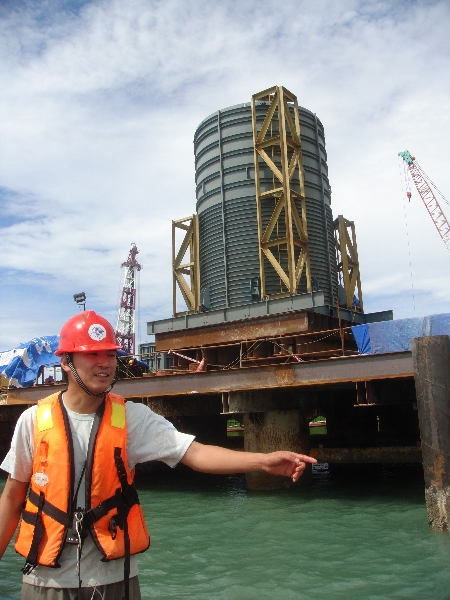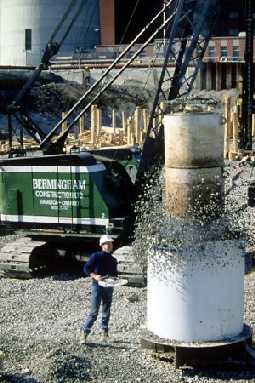StatNamic Load Testing
StatNamic Load Testing
The StatNamic Load Test is a type of test for assessing the load-carrying capacity of deep foundations which is faster and less expensive than a Static Load Test. StatNamic is like StatRapid one of the methods for performing Rapid Load Testing: powerful quasi static test methods for determining the static load capacity of piles in compliance with ASTM D7383 and EuroCode 22477-10
Key Characteristics
- Fast method for high strain pile testing
- Embodies advantages of SLT and DLT and eliminates disadvantages of these
- Direct measurement of force and displacements
- Load-settlement diagram as direct output without a stress wave analysis (no signal matching)
- Test execution user independent
- High accuracy, reliability and reproducible
- Fully compliant with international standards (ASTM, EuroCode, etc)
Rapid Load Testing is a method were a pile is loaded in a short moment, giving a gentle push on the pile top. This method is much faster than static load testing. The duration of the load is much longer than during a Dynamic Load Test (DLT), High Strain Dynamic Test or PDA. Due to the long duration of the load, no stress waves phenomena are involved. When the requirements of the quasi static situation are fulfilled, the interpretation of the Rapid Load Test results are straightforward, without stress wave analysis and without Signal Matching. As a result, the results of Rapid Load Tests are more accurate, reliable, and man-independent.
Rapid Load Testing has two major test methods: StatNamic and StatRapid.
Want to know more about Rapid Load Testing? Contact Joost Bakker at bakker@allnamics.com
StatNamic
StatNamic is the quasi-static, high-strain test method for the determination of the bearing capacity of foundation piles.
StatNamic testing works by accelerating a mass upward that, in turn, imparts a load onto the foundation pile below the StatNamic device. The load is applied and removed smoothly, resulting in a load application of 100 to 200 milliseconds. This is 30 to 40 times the duration of dynamic pile load testing. As the loading duration is relatively long, piles under 40 m remain in compression throughout, resulting in negligible stress wave effects and potentially more straightforward analysis. For foundation design, it is necessary to derive the equivalent static load-settlement curve from the StatNamic data. The simplest form of StatNamic analysis to obtain equivalent static pile response is the unloading point method (UPM). The UPM analysis method was conceived to be simple and based on measured results alone (Middendorp et al., 1992).
The StatNamic test applies a force to the pile head over a typical duration of 120 milliseconds by the controlled venting of high-pressure gas. The gas is the product of the combustion of a fast-burning fuel within a piston (fuel chamber). At the top of the piston are vent holes sealed by the load hanger, retaining the reaction mass. At some point, the pressure within the piston is of such a magnitude that it forces the load hanger arrangement upward at accelerations in order of 20g. This process applies a load downwards on the test pile.
During the loading sequence, the load applied to the test pile is monitored by a calibrated load cell incorporated in the base of the combustion piston. Pile settlement is measured using the Allnamics Reyca optical system. The data is captured using the PDR data acquisition system connected to a field computer.
THE STATNAMIC TEST DEVICE
The StatNamic weight packs usually consist of steel or concrete rings placed over the StatNamic silencer. As the device does not rely on gravity to apply loads as in static or drop weight testing, it can be used vertically, horizontally, and inclined to test raked piles. The ability to test horizontally has led to the method used for lateral load testing of piles and simulation of ship impacts on mooring bodies.
To improve the flexibility of the device and minimize transportation costs for offshore works, a device that can apply up to 14 MN using water as a reaction mass has also been tested. This is achieved in over-water pile tests by connecting the StatNamic device to a vessel full of water below the water body’s surface, thus removing the need for heavy reaction weights.
The only significant difference between the smaller and larger testing devices is the method of catching the reaction mass. The catching method for larger tests uses gravel. This is achieved by placing the StatNamic device on the test pile and lowering the reaction mass onto its hanger. A large container is then placed around the assembly and filled with gravel. As the StatNamic weights move upwards, the gravel fills the void left and supports the weights once movement has ceased. Due to the time required to place and remove the gravel after testing, this method is reserved for tests above 16 MN. Smaller rigs utilize a hydraulic catching mechanism to catch the mass within the device’s frame. This allows up to ten individual piles to be tested in a day or multiple cycles on a single pile at 15-minute intervals.
ALLWAVE-RLT
With the AllWave-RLT software, the relationship between the StatNamic mass, the amount of combustion fuel, and the test load can be determined before the tests. As part of the AllWave Software Package, this software program simulates the StatNamic Load Tests, incorporating all possible influences from pile, soil and testing setup. With AllWave-RLT, an efficient StatNamic test can be prepared.
MONITORING SENSORS
The monitoring system of the Rapid Load Testing (StatNamic, StatRapid) consists of the PDR data acquisition unit and sensors recording the following quantities at the pile top:
- The load, measured with load cells
- Displacements with the Allnamics Reyca optical system with a reflector mounted on the pile
- Accelerations
Direct measurements of loads and settlements give direct measured load-settlement diagrams. The static load diagram is obtained by analyzing the results using the Unloading Point Method, according to ASTM and EuroCodes (and other codes).
SPECIFICATIONS AND CODES
The Rapid Load Testing tests comply with a.o. ASTM D7383, EuroCode EN ISO-22477-10, and other national codes (i.e., Dutch CUR-230). StatNamic Load Testing is routinely used as an alternative to ASTM D1143 (compression tests), ASTM D3689 (Tension pile test or anchors), ASTM D3966 (for lateral pile testing) and ASTM D1194 (plate load test).
According to these codes:
- Test data analysis based on user-independent principles,
- No signal matching is required.
- Taking into account loading rate dependencies of the soil (as for DLT and PDA)
ADVANTAGES
- Test data analysis based on user-independent principles,
- No signal matching is required.
- Taking into account loading rate dependencies of the soil (as for DLT and PDA)
STATNAMIC LOAD TESTING ON YOUTUBE
- Discovery Channel Documentary StatNamic
- Biggest StatNamic Pile Test in the world: 107 MN
- StatNamic tests (playlist)
- StatNamic Load Test by Geonamics
- StatNamic test at Marina IR Project at Singapore
- Rapid Load Testing for wind farms
- StatRapid tests
- Rapid Load Testing, DownTown at The Hague, The Netherlands
- StatRapid tests
See also our YouTube Allnamics channel and YouKu Allnamics channel




